Summer Discrepancies between 2 m Air Temperature and Landsat LST in Suceava City, Northeastern Romania
Abstract
:1. Introduction
2. Materials and Methods
2.1. Study Area
2.2. Data
2.3. Methods
2.3.1. Gap Filling of Land Surface Temperature
2.3.2. Interpolation of Tair2m Data
2.3.3. Methods for Ancillary Remote Sensing Data Treatments
Kernel Density (KDE) of Impervious Density (IMD) for 2018
Local Climate Zones (LCZs) Classification
3. Results and Discussion
3.1. Thermal Differences Results between Tair2m and Landsat Surveys
3.2. Thermal Differences between Tair2m and LST Conditioned by the Imperviouss Density
3.3. Thermal Differences between Tair2m and LST Conditioned by LCZ
4. Conclusions
Supplementary Materials
Author Contributions
Funding
Data Availability Statement
Acknowledgments
Conflicts of Interest
References
- Zhou, D.; Xiao, J.; Bonafoni, S.; Berger, C.; Deilami, K.; Zhou, Y.; Frolking, S.; Yao, R.; Qiao, Z.; Sobrino, J.A. Satellite Remote Sensing of Surface Urban Heat Islands: Progress, Challenges, and Perspectives. Remote Sens. 2019, 11, 48. [Google Scholar] [CrossRef]
- Weng, Q. Thermal infrared remote sensing for urban climate and environmental studies: Methods, applications, and trends. ISPRS J. Photogramm. Remote Sens. 2009, 64, 335–344. [Google Scholar] [CrossRef]
- He, B.-J.; Wang, W.; Sharifi, A.; Liu, X. Progress, knowledge gap and future directions of urban heat mitigation and adaptation research through a bibliometric review of history and evolution. Energy Build. 2023, 287, 112976. [Google Scholar] [CrossRef]
- Lin, W.; Yu, T.; Chang, X.; Wu, W.; Zhang, Y. Calculating cooling extents of green parks using remote sensing: Method and test. Landsc. Urban Plan. 2015, 134, 66–75. [Google Scholar] [CrossRef]
- Farid, N.; Moazzam, M.F.U.; Ahmad, S.R.; Coluzzi, R.; Lanfredi, M. Monitoring the Impact of Rapid Urbanization on Land Surface Temperature and Assessment of Surface Urban Heat Island Using Landsat in Megacity (Lahore) of Pakistan. Front. Remote Sens. 2022, 3, 897397. [Google Scholar] [CrossRef]
- Yang, H.; Xi, C.; Zhao, X.; Mao, P.; Wang, Z.; Shi, Y.; He, T.; Li, Z. Measuring the Urban Land Surface Temperature Variations Under Zhengzhou City Expansion Using Landsat-Like Data. Remote Sens. 2020, 12, 801. [Google Scholar] [CrossRef]
- Schwaab, J.; Meier, R.; Mussetti, G.; Seneviratne, S.; Bürgi, C.; Davin, E.L. The role of urban trees in reducing land surface temperatures in European cities. Nat. Commun. 2021, 12, 6763. [Google Scholar] [CrossRef] [PubMed]
- Hossain, M.A.; Sultana, S.; Siddiqui, M.R. Effects of the Nature of Urban Development on Land Surface Temperature (LST) at the Neighbourhood Scale in Dhaka City, Bangladesh. Environ. Urban. ASIA 2022, 13, 284–303. [Google Scholar] [CrossRef]
- Tahooni, A.; Kakroodi, A.A.; Kiavarz, M. Monitoring of land surface albedo and its impact on land surface temperature (LST) using time series of remote sensing data. Ecol. Inform. 2023, 75, 102118. [Google Scholar] [CrossRef]
- An, H.; Cai, H.; Xu, X.; Qiao, Z.; Han, D. Impacts of Urban Green Space on Land Surface Temperature from Urban Block Perspectives. Remote Sens. 2022, 14, 4580. [Google Scholar] [CrossRef]
- Unger, J.; Savić, S.; Gál, T. Modelling of the Annual Mean Urban Heat Island Pattern for Planning of Representative Urban Climate Station Network. Adv. Meteorol. 2011, 2011, 398613. [Google Scholar] [CrossRef]
- Fenner, D.; Meier, F.; Bechtel, B.; Otto, M.; Scherer, D. Intra and inter local climate zone variability of air temperature as observed by crowdsourced citizen weather stations in Berlin, Germany. Meteorol. Z. 2017, 26, 525–547. [Google Scholar] [CrossRef]
- He, B.J.; Wang, J.; Liu, H.; Ulpiani, G. Localized synergies between heat waves and urban heat islands: Implications on human thermal comfort and urban heat management. Environ. Res. 2021, 193, 110584. [Google Scholar] [CrossRef] [PubMed]
- Cheval, S.; Amihăesei, V.A.; Chitu, Z.; Dumitrescu, A.; Falcescu, V.; Irașoc, A.; Micu, D.; Mihulet, E.; Ontel, I.; Paraschiv, M.G.; et al. A systematic review of urban heat island and heat waves research (1991–2022). Clim. Risk Manag. 2024, 44, 100603. [Google Scholar] [CrossRef]
- Sfîcă, L.; Crețu, Ș.-C.; Ichim, P.; Hrițac, R.; Breabăn, I. Surface urban heat island of Iași city (Romania) and its differences from in situ screen-level air temperature measurements. Sustain. Cities Soc. 2023, 94, 104568. [Google Scholar] [CrossRef]
- White-Newsome, J.L.; Brines, S.J.; Brown, D.G.; Dvonch, J.T.; Gronlund, C.J.; Zhang, K.; Oswald, E.M.; O’Neill, M.S. Validating Satellite-Derived Land Surface Temperature with in Situ Measurements: A Public Health Perspective. Environ. Health Perspect. 2013, 121, 925–931. [Google Scholar] [CrossRef] [PubMed]
- Puche, M. Analysis of Temperature Variation with Respect to the LCZs Using In-Situ Measures and Satellite Imagery: Study Case of the Metropolitan City of Milan. Master’s Thesis, School of Civil Environmental and Land Management Engineering School of Industrial and Information Engineering, Politecnico Milano, Milan, Italy, 2022; 87p. [Google Scholar]
- Xiong, Y.; Chen, F. Correlation analysis between temperatures from Landsat thermal infrared retrievals and synchronous weather observations in Shenzhen, China. Remote Sens. Appl. Soc. Environ. 2017, 7, 40–48. [Google Scholar] [CrossRef]
- Marzban, F.; Sodoudi, S.; Preusker, R. The influence of land-cover type on the relationship between NDVI–LST and LST-Tair. Int. J. Remote Sens. 2017, 39, 1377–1398. [Google Scholar] [CrossRef]
- Yang, C.; He, X.; Yan, F.; Yu, L.; Bu, K.; Yang, J.; Chang, L.; Zhang, S. Mapping the Influence of Land Use/Land Cover Changes on the Urban Heat Island Effect—A Case Study of Changchun, China. Sustainability 2017, 9, 312. [Google Scholar] [CrossRef]
- Majkowska, A.; Kolendowicz, L.; Półrolniczak, M.; Hauke, J.; Czernecki, B. The urban heat island in the city of Poznań as derived from Landsat 5 TM. Theor. Appl. Climatol. 2017, 128, 769–783. [Google Scholar] [CrossRef]
- Matuzko, A.K.; Yakubailik, O.E. Urban heat island effects over Krasnoyarsk obtained on the basis of Landsat 8 remote sensing data. IOP Conf. Ser. Earth Environ. Sci. 2018, 211, 012010. [Google Scholar] [CrossRef]
- García, D.H. Analysis and precision of the Terrestrial Surface Temperature using Landsat 8 and Sentinel 3 images: Study applied to the city of Granada (Spain). Sustain. Cities Soc. 2021, 71, 102980. [Google Scholar] [CrossRef]
- Cheval, S.; Dumitrescu, A. The July urban heat island of Bucharest as derived from MODIS images. Theor. Appl. Climatol. 2009, 96, 145–153. [Google Scholar] [CrossRef]
- Cheval, S.; Dumitrescu, A. The summer surface urban heat island of Bucharest (Romania) retrieved from MODIS images. Theor. Appl. Climatol. 2015, 121, 631–640. [Google Scholar] [CrossRef]
- Dumitrică, C.; Ciupitu, D.; Grigorescu, I. Spatial characteristics of the land surface temperature in Bucharest metropolitan area. Rom. J. Geogr. 2018, 62, 3–17. [Google Scholar]
- Ionac, N.; Grigore, E. Thermal Differences within Bucharest Town Area. Case Study: 01.07.2006–31.03.2007. Present Environ. Sustain. Dev. 2013, 7, 21–36. [Google Scholar]
- Vlăducu, M.; Tâştea, D.; Dragotă, C.-S.; Grigorescu, I.; Kucsicsa, G. Urban influences on air temperature and relative humidity of moist air distribution in Bucharest Municipality. Heat Island. Ann. Univ. Craiova Ser. Geogr. 2007, 10, 13–20. [Google Scholar]
- Sfîcă, L.; Ichim, P.; Apostol, L.; Ursu, A. The extent and intensity of the urban heat island in Iasi City, Romania. Theor. Appl. Climatol. 2018, 134, 777–791. [Google Scholar] [CrossRef]
- Ichim, P.; Sfîcă, L. The Influence of Urban Climate on Bioclimatic Conditions in the City of Iași, Romania. Sustainability 2020, 12, 9652. [Google Scholar] [CrossRef]
- Cheval, S.; Dumitrescu, A.; Bell, A. The urban heat island of Bucharest during the extreme high temperature of July 2007. Theor. Appl. Climatol. 2009, 97, 391–401. [Google Scholar] [CrossRef]
- Udristoiu, M.T.; Velea, L.; Bojariu, R.; Sararu, S.C. Assessment of Urban Heat Island for Craiova from satellite-based LST. AIP Conf. Proc. 2017, 1916, 040004. [Google Scholar] [CrossRef]
- Cheval, S.; Dumitrescu, A.; Irașoc, A.; Paraschiv, M.G.; Perry, M.; Ghent, D. MODIS-based climatology of the Surface Urban Heat Island at country scale (Romania). Urban Clim. 2022, 41, 101056. [Google Scholar] [CrossRef]
- Bălteanu, D.; Apostol, L. Impactul schimbărilor climatice asupra mediului urban din București. Rom. J. Geogr. 2014, 58, 5–16. [Google Scholar]
- Căpățână, D.E.; Vasilescu, F. Analiza insulelor de căldură urbane în București cu ajutorul imaginilor satelitare Landsat 8. Bul. Soc. Române Geogr. 2015, 54, 73–84. [Google Scholar]
- Gherman, I.; Bejan, A. Spatial and temporal variability of the surface urban heat island in Timișoara, Romania. Theor. Appl. Climatol. 2014, 117, 435–448. [Google Scholar]
- Munteanu, I.; Boroneanț, C. The impact of urban green spaces on surface temperature in Timișoara, Romania. Urban Clim. 2017, 22, 1–12. [Google Scholar]
- Onea, F.; Abrudan, I.V. Assessing the relationship between land use/cover and surface urban heat island in Cluj-Napoca, Romania. Carpath. J. Earth Environ. Sci. 2016, 11, 339–350. [Google Scholar]
- Pătru-Stupariu, I.; Roșca, B. The influence of land use changes on the surface urban heat island in Cluj-Napoca, Romania. Climate 2018, 6, 55. [Google Scholar]
- Corocăescu, A.; Ichim, P.; Crețu, Ș.-C.; Dior, A.; Șerban, L.; Amihăesei, V.-A.; Sfîcă, L. Assessment of Climate Characteristics of an Urban Park Using Satellite Imagery and In-Situ Measurements. Study Case of Cancicov Park from Bacău City (Romania). In Proceedings of the “Air and Water-Components of the Environment” Conference Proceedings, Cluj-Napoca, Romania, 17–19 March 2023; pp. 33–46. [Google Scholar] [CrossRef]
- Rostam, M.G.; Beck, C. Towards the Determination of Driving Factors of Varying LST-LCZ Relationships—A Case Study over 25 Cities. Geogr. Pannon. 2019, 23, 289–307. [Google Scholar] [CrossRef]
- Lamb, W.F.; Creutzig, F.; Callaghan, M.W.; Minx, J.C. Learning about urban climate solutions from case studies. Nat. Clim. Change 2019, 9, 279–287. [Google Scholar] [CrossRef]
- National Agency for Cadastre and Land Registration. Available online: https://www.ancpi.ro/en/ (accessed on 10 January 2024).
- National Institute of Statistics. TEMPO-Online Database. Available online: http://statistici.insse.ro/shop/ (accessed on 22 September 2023).
- Prisacariu, A. Climatic, Topoclimatic and Microclimatic Study of the Metropolitan Area of Suceava Municipality. Ph.D. Thesis, “Ștefan cel Mare” University of Suceava, Suceava, Romania, 2023. (In Romanian). [Google Scholar]
- Copernicus Land Monitoring Service. CORINE Land Cover. 2018 Dataset. Available online: https://land.copernicus.eu/en/products/corine-land-cover/clc2018 (accessed on 22 September 2023).
- Copernicus Land Monitoring Service. CORINE Land Cover. 1990 Dataset. Available online: https://land.copernicus.eu/en/products/corine-land-cover/clc-1990 (accessed on 22 September 2023).
- USGS EarthExplorer. Available online: https://earthexplorer.usgs.gov/ (accessed on 22 September 2023).
- He, B.-J. Potentials of meteorological characteristics and synoptic conditions to mitigate urban heat island effects. Urban Clim. 2018, 24, 26–33. [Google Scholar] [CrossRef]
- Earthdata. Available online: https://www.earthdata.nasa.gov/ (accessed on 22 September 2023).
- Zhou, W.; Peng, B.; Shi, J. Reconstructing spatial–temporal continuous MODIS land surface temperature using the DINEOF method. J. Appl. Remote Sens. 2017, 11, 046016. [Google Scholar] [CrossRef]
- Beckers, J.M.; Rixen, M. EOF Calculations and Data Filling from Incomplete Oceanographic Datasets. J. Atmos. Ocean. Technol. 2003, 20, 1839–1856. [Google Scholar] [CrossRef]
- Álvera-Azcárate, A.; Barth, A.; Rixen, M.; Beckers, J. Reconstruction of incomplete oceanographic data sets using empirical orthogonal functions: Application to the Adriatic Sea surface temperature. Ocean Model. 2005, 9, 325–346. [Google Scholar] [CrossRef]
- Beckers, J.M.; Barth, A.; Alvera-Azcárate, A. DINEOF reconstruction of clouded images including error maps: Application to the sea-surface temperature around Corsican Island. Ocean Sci. 2006, 2, 183–199. [Google Scholar] [CrossRef]
- Cheval, S.; Dumitrescu, A.; Amihăesei, V.A. Exploratory analysis of urban climate using a gap-filled Landsat 8 Land Surface Temperature Data Set. Sensors 2020, 20, 5336. [Google Scholar] [CrossRef] [PubMed]
- Sfîcă, L.; Corocăescu, A.-C.; Crețu, Ș.-C.; Amihăesei, V.-A.; Ichim, P. Spatiotemporal Features of the Surface Urban Heat Island of Bacău City (Romania) during the Warm Season and Local Trends of LST Imposed by Land Use Changes during the Last 20 Years. Remote Sens. 2023, 15, 3385. [Google Scholar] [CrossRef]
- Amihăesei, V.A.; Crețu, Ș.-C.; Ichim, P.; Sfîcă, L. Traitement des images satellitaires pour l’evaluation du climat urbain au nord-est de la Roumanie. In Proceedings of the 36ème Colloque de l’Association Internationale de Climatologie, Bucharest, Romania, 3–7 July 2023; pp. 17–20. [Google Scholar]
- Filipponi, F. rtsa: Raster Time Series Analysis. R Package Version 0.3. 2019. Available online: https://github.com/ffilipponi/rtsa (accessed on 10 January 2024).
- R Core Team. R: A Language and Environment for Statistical Computing; R Foundation for Statistical Computing: Vienna, Austria, 2022; Available online: https://www.r-project.org/ (accessed on 22 September 2023).
- Copernicus Land Monitoring Service. High Resolution Layer Imperviousness. 2018 Dataset. Available online: https://doi.org/10.2909/3bf542bd-eebd-4d73-b53c-a0243f2ed862 (accessed on 22 September 2023).
- Silverman, B.W. Density Estimation for Statistics and Data Analysis; Chapman and Hall: New York, NY, USA, 1986; 186p. [Google Scholar]
- Li, H.; Zhou, Y.; Li, X.; Meng, L.; Wang, X.; Wu, S.; Sodoudi, S.A. A new method to quantify surface urban heat island intensity. Sci. Total Environ. 2018, 624, 262–272. [Google Scholar] [CrossRef] [PubMed]
- Stewart, I.D.; Oke, T.R. Local Climate Zones for Urban Temperature Studies. Bull. Am. Meterol. Soc. 2012, 93, 1879–1900. [Google Scholar] [CrossRef]
- Demuzere, M.; Kittner, J.; Bechtel, B. LCZ Generator: A web application to create Local Climate Zone maps. Front. Environ. Sci. 2021, 9, 637455. [Google Scholar] [CrossRef]
- Almeida, C.R.d.; Teodoro, A.C.; Gonçalves, A. Study of the Urban Heat Island (UHI) Using Remote Sensing Data/Techniques: A Systematic Review. Environments 2021, 8, 105. [Google Scholar] [CrossRef]
- Liu, X.; Ming, Y.; Liu, Y.; Yue, W.; Han, G. Influences of landform and urban form factors on urban heat island: Comparative case study between Chengdu and Chongqing. Sci. Total Environ. 2022, 820, 153395. [Google Scholar] [CrossRef] [PubMed]
- Ivan, K.; Benedek, J. The assessment relationship between land surface temperature (LST) and built-up area in urban agglomeration. Case study: Cluj-Napoca, Romania. Geogr. Tech. 2017, 12, 64–74. [Google Scholar] [CrossRef]
- Lindberg, F.; Onomura, S.; Grimmond, C.S.B. Influence of ground surface characteristics on the mean radiant temperature in urban areas. Int. J. Bioclimatol. 2016, 60, 1439–1452. [Google Scholar] [CrossRef] [PubMed]
- Crețu, Ș.-C.; Ichim, P.; Sfîcă, L. Summer urban heat island of Galați city (Romania) detected using satellite products. Present Environ. Sustain. Dev. 2020, 14, 5–27. [Google Scholar] [CrossRef]
- Elmes, A.; Healy, M.; Geron, N.; Andrews, M.M.; Rogan, J.; Martin, D.G.; Sangermano, F.; William, C.A.; Weil, B. Mapping spatiotemporal variability of the urban heat island across an urban gradient in Worcester, Massachusetts using in-situ Thermochrons and Landsat-8 Thermal Infrared Sensor (TIRS) data. GISci. Remote Sens. 2020, 57, 845–864. [Google Scholar] [CrossRef]
- Shi, Z.; Li, X.; Hu, T.; Yuan, B.; Yin, P.; Jiang, D. Modeling the intensity of surface urban heat island based on the impervious surface area. Urban Clim. 2023, 49, 101529. [Google Scholar] [CrossRef]
- Cai, M.; Ren, C.; Xu, Y.; Lau, K.; Wang, R. Investigating the relationship between local climate zone and land surface temperature using an improved WUDAPT methodology—A case study of Yangtze River Delta, China. Urban Clim. 2017, 24, 485–502. [Google Scholar] [CrossRef]
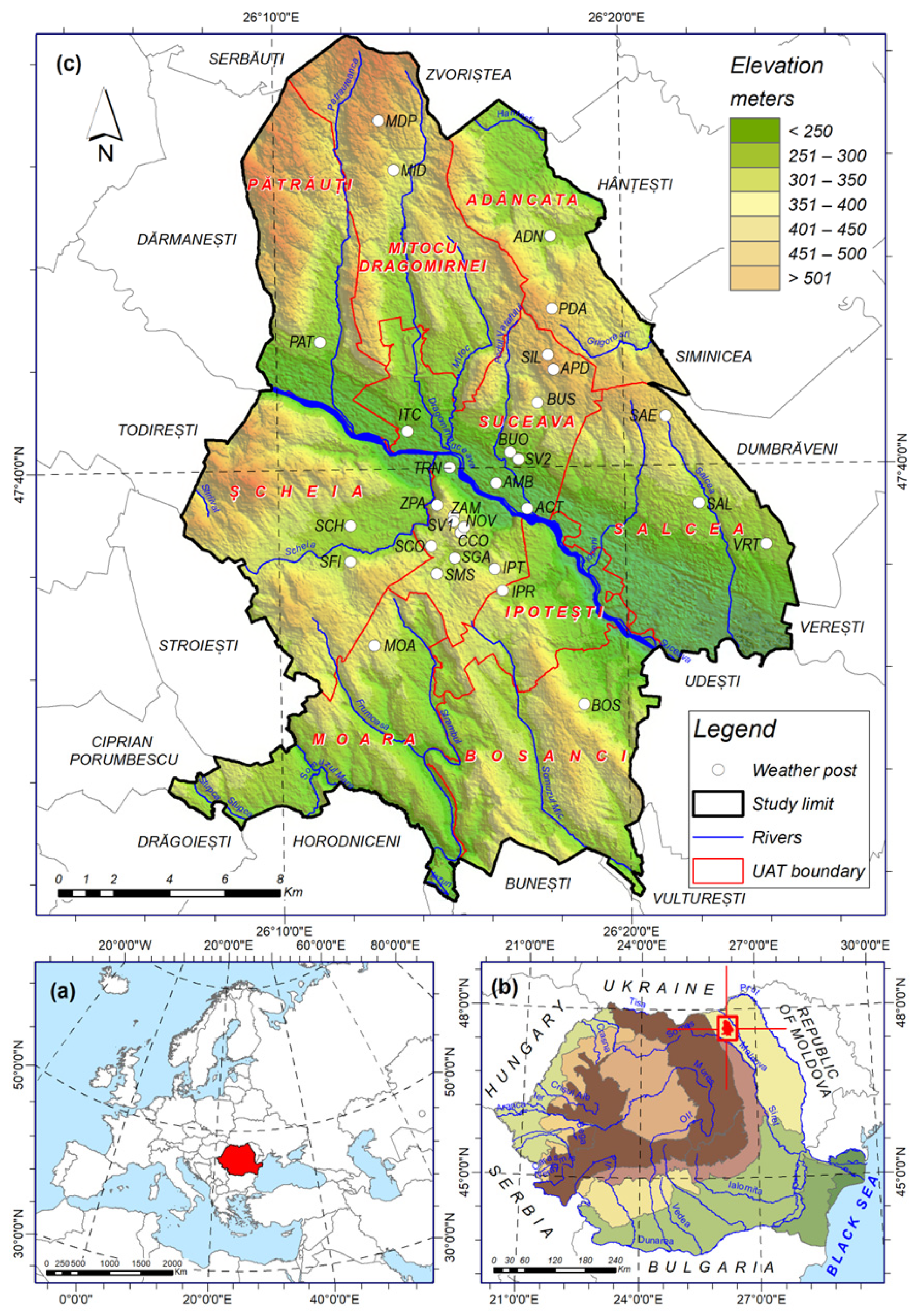


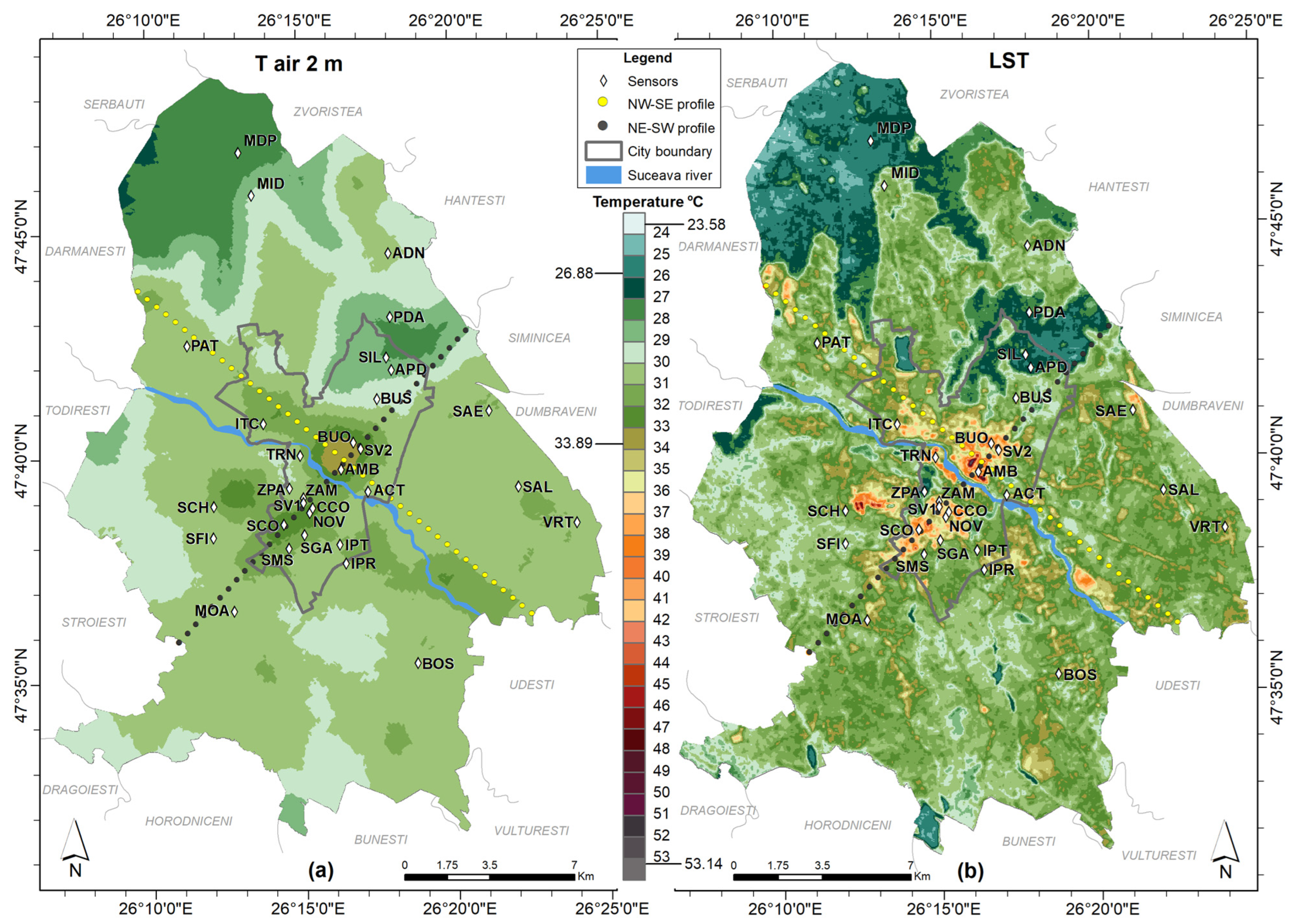
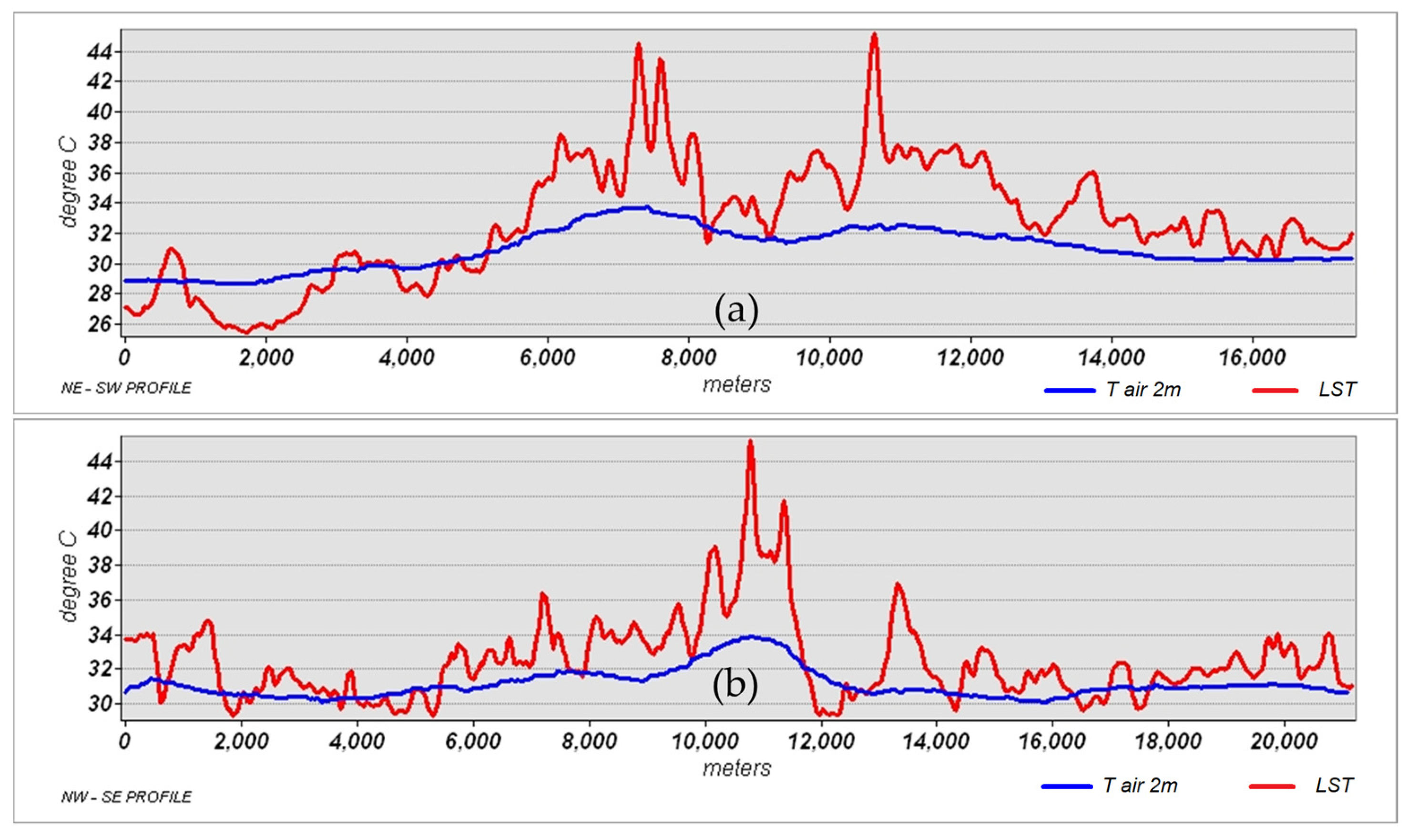
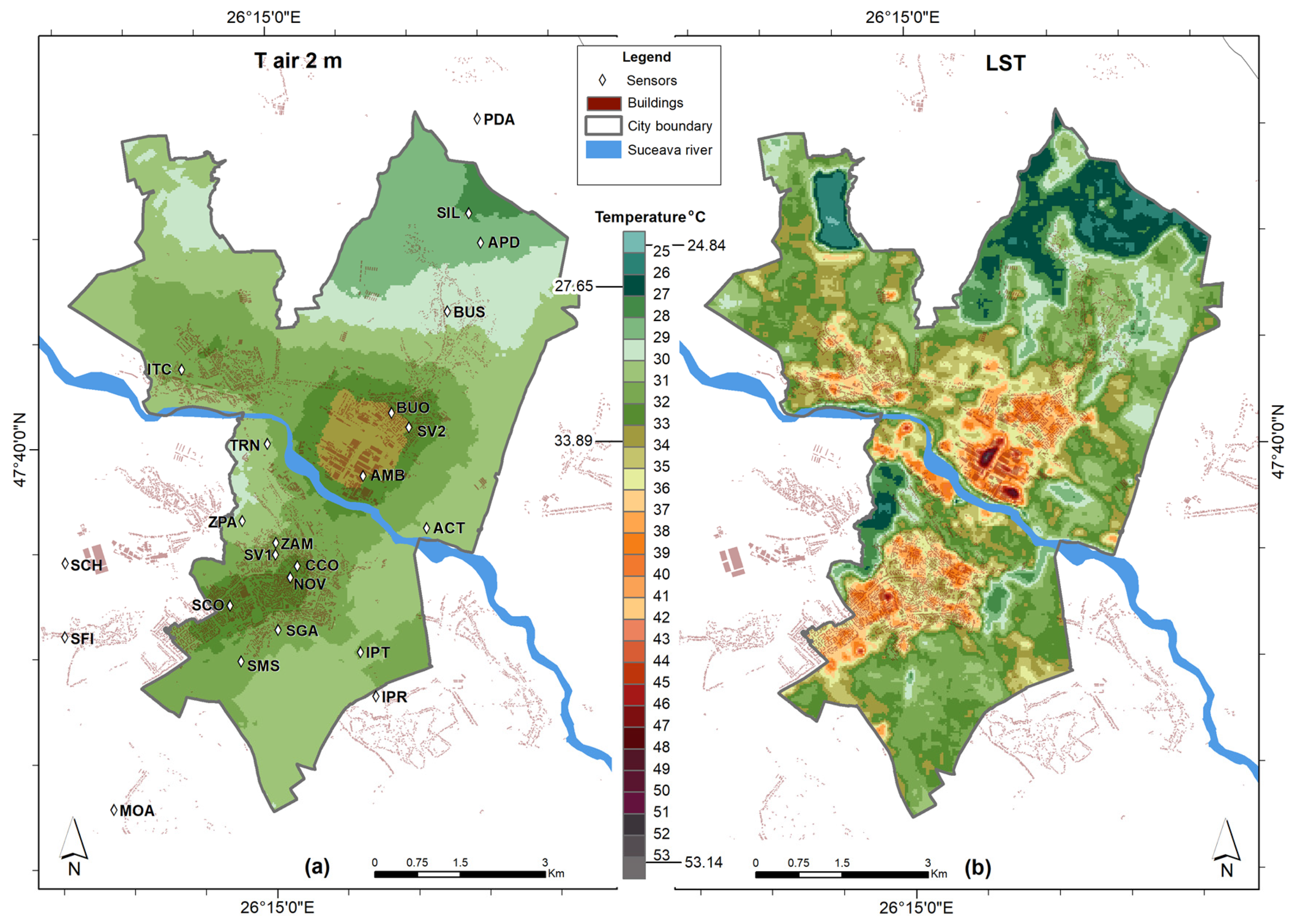

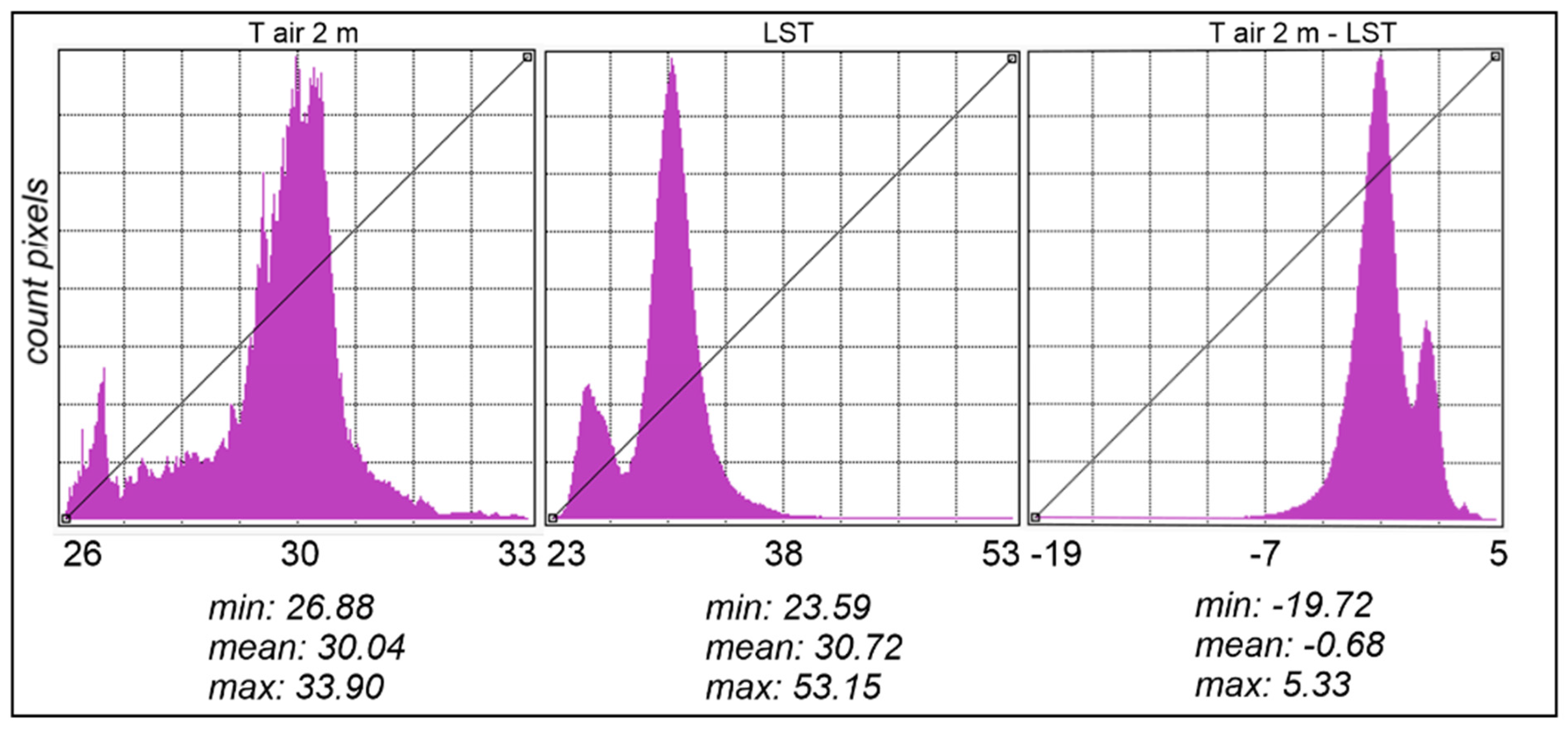
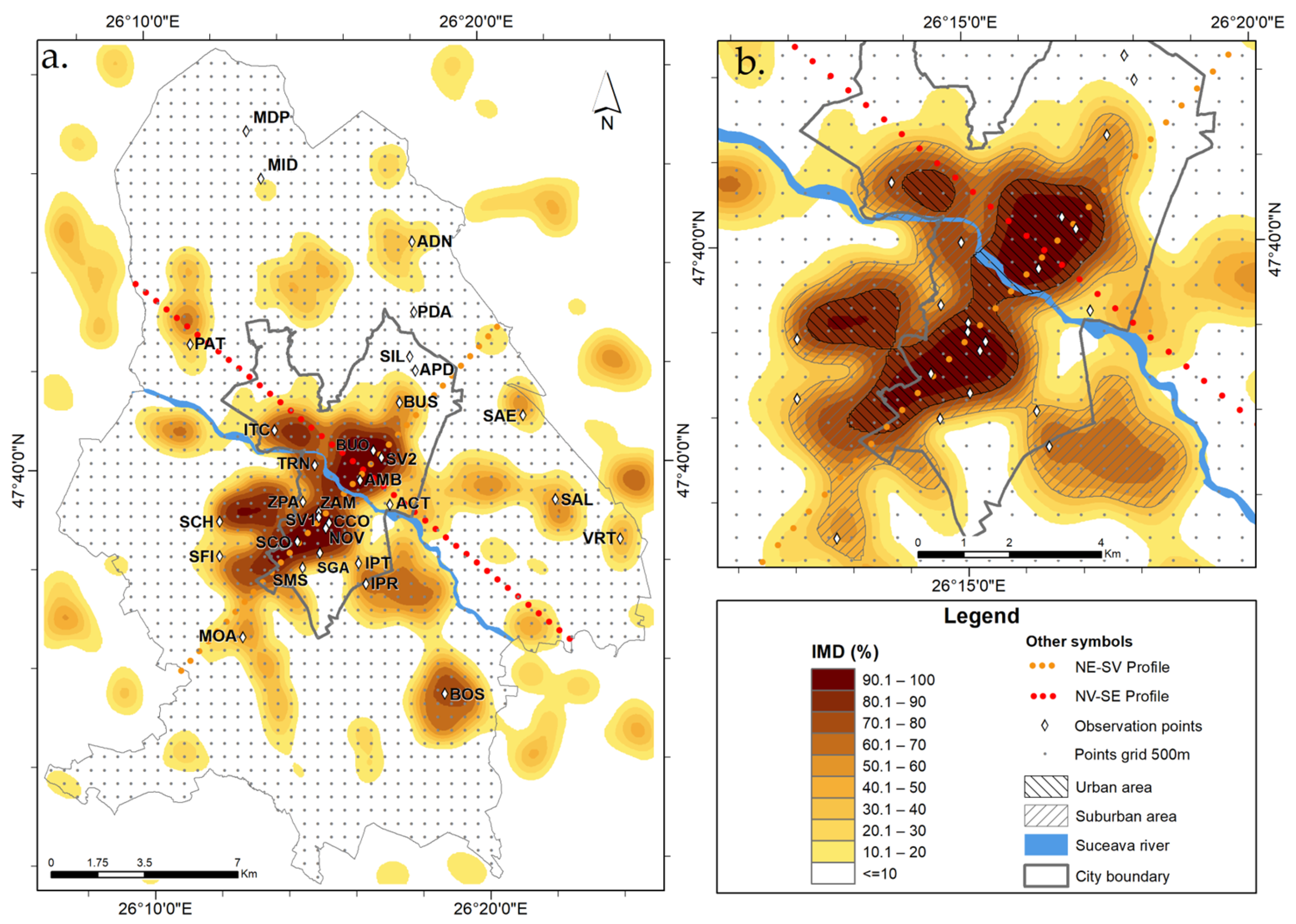
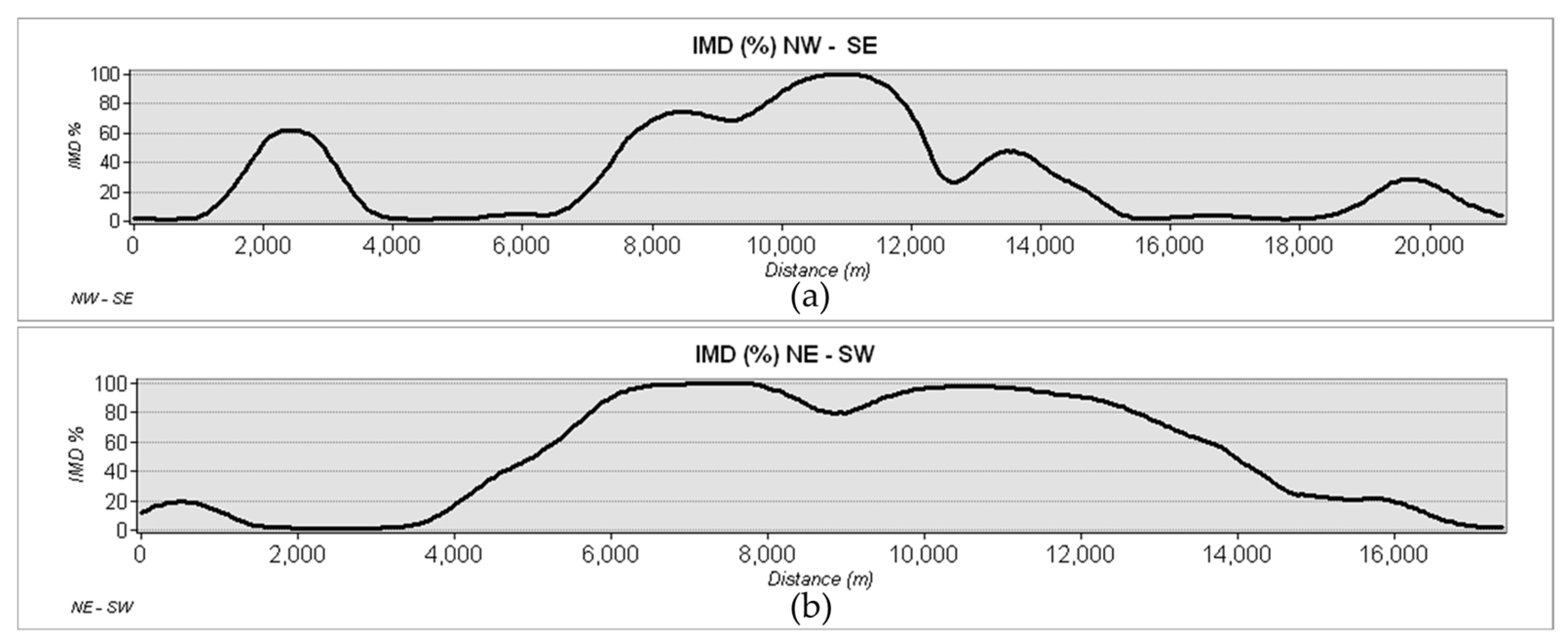
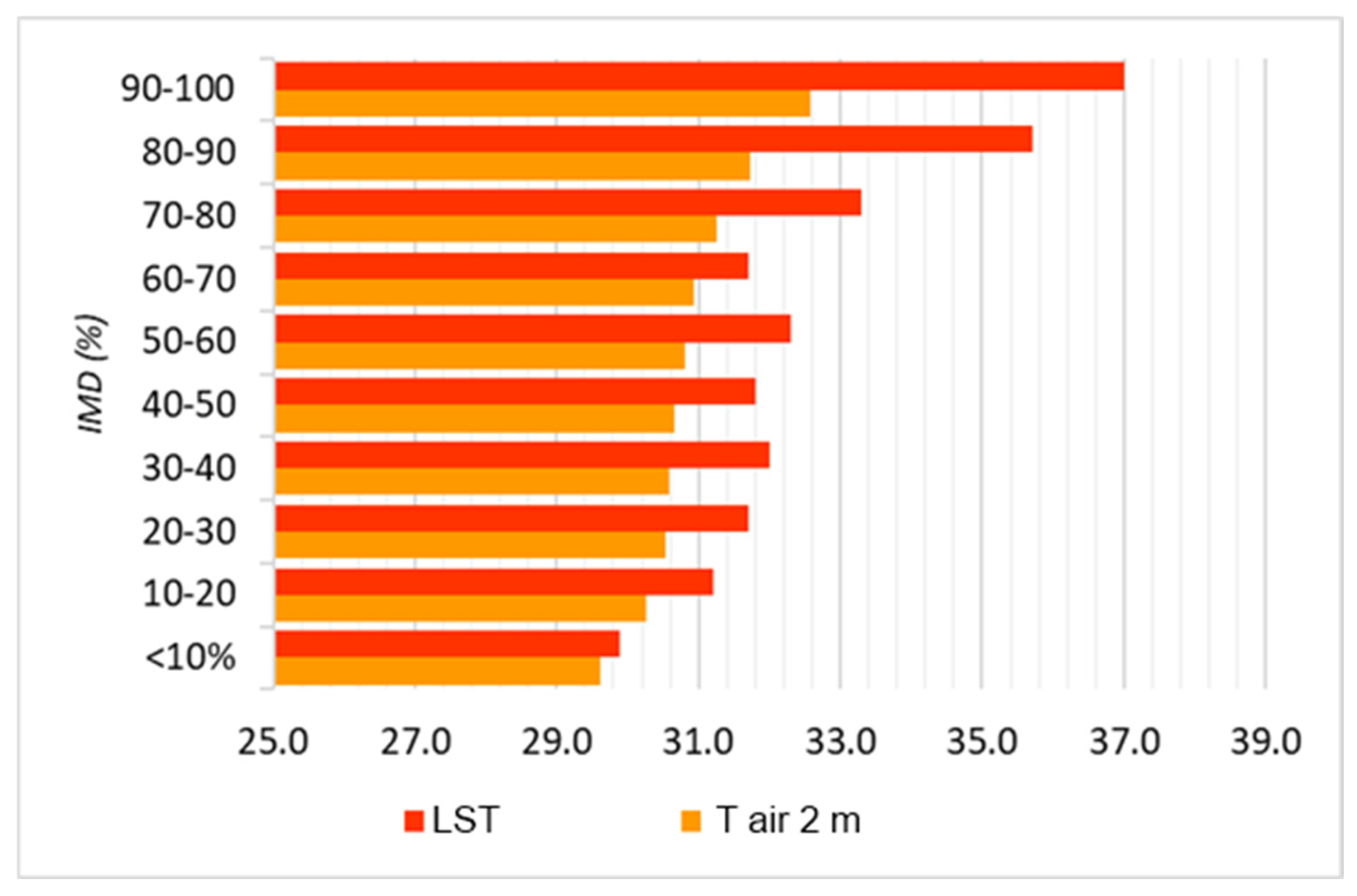
| Satellites | Sensors | Bands | Spatial Resolution | Temporal Resolution | Paths | Row | Pass Time (GMT) | No. of Data Series |
|---|---|---|---|---|---|---|---|---|
| Landsat 7 | ETM+ | Band 6 | 60 *(30) m | 16 days | 183/184 | 27 | 08:05–08:52 | 11 |
| Landsat 8 | OLI&TIR | Band 10 | 100 **(30) m | 16 days | 183/184 | 27 | 09:02–09:08 | 24 |
| Post | Index | ALT. | SLOPE | ASPECT | MT | MR + IDW | Dif. | MR + OK | Dif. | SR | Dif. | SR + IDW | Dif. | SR + OK | Dif. |
|---|---|---|---|---|---|---|---|---|---|---|---|---|---|---|---|
| X1 | X2 | X3 | A | B | A–B | C | A–C | D | A–D | E | A–E | F | A–F | ||
| NOV | 12 | 363 | 4.69 | 130.24 | 29.5 | 30.6 | 1.1 | 29.1 | 0.4 | 29.4 | 0.1 | 31.6 | 2.1 | 29.1 | 0.4 |
| IPT | 16 | 358 | 5.94 | 256.61 | 28.4 | 28.2 | 0.2 | 29.2 | 0.7 | 29.4 | 1.0 | 29.2 | 0.8 | 29.2 | 0.7 |
| SFI | 15 | 356 | 4.74 | 305.54 | 28.4 | 28.2 | 0.2 | 29.2 | 0.8 | 29.4 | 1.1 | 28.2 | 0.2 | 29.2 | 0.8 |
| ZAM | 9 | 368 | 4.56 | 115.02 | 30.4 | 29.9 | 0.5 | 29.1 | 1.2 | 29.4 | 1.0 | 28.9 | 1.5 | 29.1 | 1.2 |
| APD | 23 | 455 | 8.50 | 290.77 | 28.2 | 29.4 | 1.2 | 29.1 | 0.9 | 29.1 | 0.9 | 29.4 | 1.2 | 29.1 | 0.9 |
| VRT | 24 | 312 | 9.32 | 229.76 | 29.0 | 28.0 | 0.9 | 29.8 | 0.8 | 29.6 | 0.6 | 30.0 | 1.1 | 29.8 | 0.8 |
| Mean | 0.7 | 0.8 | 0.8 | 1.1 | 0.8 | ||||||||||
| Surface Area | TAir2m | LST | TAir2m—LST | ||||||
|---|---|---|---|---|---|---|---|---|---|
| Min | Avg | Max | Min | Avg | Max | Min | Avg | Max | |
| Urban area (IMD > 80%) | 30.6 | 32.2 | 33.9 | 26.9 | 35.8 | 53.2 | 3.7 | −3.6 | −19.3 |
| Peri-urban area (IMD 40–80%) | 29.3 | 31.0 | 32.7 | 25.2 | 32.6 | 44.7 | 4.1 | −1.6 | −12 |
| Rural area (IMD < 40%) | 26.9 | 29.9 | 32.1 | 23.6 | 30.4 | 39.1 | 3.3 | −0.5 | −7 |
| IMD | TAir2m | LST | TAir2m—LST | ||||||
|---|---|---|---|---|---|---|---|---|---|
| % | Min | Avg | Max | Min | Avg | Max | Min | Avg | Max |
| <10% | 26.9 | 29.6 | 32.0 | 24.2 | 29.9 | 38.0 | 2.7 | −0.3 | −6.0 |
| 10–20 | 28.3 | 30.3 | 33.4 | 26.4 | 31.2 | 36.7 | 1.9 | −0.9 | −3.3 |
| 20–30 | 29.2 | 30.5 | 31.4 | 27.3 | 31.7 | 35.4 | 1.9 | −1.2 | −4.0 |
| 30–40 | 29.5 | 30.6 | 31.4 | 28.1 | 32.0 | 37.8 | 1.4 | −1.4 | −6.4 |
| 40–50 | 29.6 | 30.7 | 31.6 | 26.6 | 31.8 | 35.4 | 3.0 | −1.1 | −3.8 |
| 50–60 | 29.6 | 30.8 | 31.7 | 28.1 | 32.3 | 36.2 | 1.5 | −1.5 | −4.5 |
| 60–70 | 30.1 | 30.9 | 31.7 | 26.5 | 31.7 | 35.2 | 3.6 | −0.8 | −3.5 |
| 70–80 | 30.2 | 31.3 | 32.6 | 28.4 | 33.3 | 36.8 | 1.8 | −2.0 | −4.2 |
| 80–90 | 30.7 | 31.7 | 32.6 | 30.9 | 35.7 | 45.0 | −0.2 | −4.0 | −12.4 |
| 90–100 | 31.4 | 32.6 | 33.9 | 31.1 | 37.0 | 45.1 | 0.3 | −4.4 | −11.2 |
 | |||||||||
| LCZ Class | Number of Meteorological Posts | The Indicatives of the Meteorological Posts | TAir2m | LST | TAir2m—LST | ||||||
|---|---|---|---|---|---|---|---|---|---|---|---|
| Min | Avg | Max | Min | Avg | Max | Min * | Avg * | Max * | |||
| 1 | 0 | - | 32.1 | 32.4 | 33.3 | 34.7 | 38.0 | 46.0 | −2.6 | −5.6 | −12.7 |
| 2 | 6 | SCO, NOV, SV1, ZAM, SV2, BUO | 29.2 | 32.0 | 33.9 | 27.0 | 35.9 | 47.2 | 2.2 | −3.9 | −13.3 |
| 3 | 3 | CCO, ACT, ITC | 29.5 | 31.3 | 33.9 | 26.1 | 33.7 | 48.5 | 3.4 | −2.4 | −14.6 |
| 5 | 0 | - | 31.5 | 31.6 | 31.7 | 32.3 | 32.8 | 33.5 | −0.8 | −1.2 | −1.8 |
| 6 | 11 | BOS, MOA, IPR, IPT, SFI, SGA, VRT, SAL, BUS, PAT, ADN | 27.2 | 30.4 | 33.8 | 25.3 | 31.7 | 47.8 | 1.9 | −1.3 | −14.0 |
| 7 | 1 | TRN | 29.7 | 31.7 | 33.7 | 28.4 | 35.7 | 47.8 | 1.3 | −4.0 | −14.1 |
| 8 | 1 | AMB | 29.6 | 32.2 | 33.9 | 26.3 | 36.5 | 53.2 | 3.3 | −4.3 | −19.3 |
| 9 | 1 | MID | 27.0 | 29.4 | 31.5 | 24.9 | 29.6 | 36.8 | 2.1 | −0.2 | −5.3 |
| 10 | 0 | - | 29.9 | 32.1 | 33.7 | 29.1 | 38.1 | 47.5 | 0.8 | −6.0 | −13.8 |
| A | 5 | ZPA, ADP, SIL, PDA, MPD | 26.9 | 28.1 | 31.9 | 23.6 | 26.5 | 36.7 | 3.3 | 1.6 | −4.8 |
| B | 0 | - | 26.9 | 29.1 | 31.7 | 24.4 | 28.6 | 35.3 | 2.5 | 0.5 | −3.6 |
| C | 0 | - | 28.7 | 30.6 | 33.2 | 25.2 | 30.9 | 38.5 | 3.5 | −0.3 | −5.3 |
| D | 3 | SMS, SCH, SAE | 27.2 | 30.4 | 33.9 | 24.9 | 31.4 | 44.7 | 2.3 | −1.0 | −10.8 |
| E | 0 | - | 29.1 | 30.9 | 33.9 | 27.2 | 32.5 | 49.9 | 1.9 | −1.6 | −16.0 |
| F | 0 | - | 28.9 | 30.8 | 31.8 | 25.7 | 31.3 | 34.4 | 3.2 | −0.5 | −2.6 |
| G | 0 | - | 27.5 | 29.8 | 32.4 | 24.8 | 28.0 | 37.8 | 2.7 | 1.8 | −5.4 |
| Thermal indices of synthesis for SvMA | 26.9 | 30.8 | 33.9 | 23.6 | 32.575 | 53.2 | 3.3 | −1.8 | −19.3 | ||
Disclaimer/Publisher’s Note: The statements, opinions and data contained in all publications are solely those of the individual author(s) and contributor(s) and not of MDPI and/or the editor(s). MDPI and/or the editor(s) disclaim responsibility for any injury to people or property resulting from any ideas, methods, instructions or products referred to in the content. |
© 2024 by the authors. Licensee MDPI, Basel, Switzerland. This article is an open access article distributed under the terms and conditions of the Creative Commons Attribution (CC BY) license (https://creativecommons.org/licenses/by/4.0/).
Share and Cite
Mihăilă, D.; Bistricean, P.-I.; Sfîcă, L.; Horodnic, V.-D.; Prisăcariu, A.; Amihăesei, V.-A. Summer Discrepancies between 2 m Air Temperature and Landsat LST in Suceava City, Northeastern Romania. Remote Sens. 2024, 16, 2967. https://doi.org/10.3390/rs16162967
Mihăilă D, Bistricean P-I, Sfîcă L, Horodnic V-D, Prisăcariu A, Amihăesei V-A. Summer Discrepancies between 2 m Air Temperature and Landsat LST in Suceava City, Northeastern Romania. Remote Sensing. 2024; 16(16):2967. https://doi.org/10.3390/rs16162967
Chicago/Turabian StyleMihăilă, Dumitru, Petruț-Ionel Bistricean, Lucian Sfîcă, Vasilică-Dănuț Horodnic, Alin Prisăcariu, and Vlad-Alexandru Amihăesei. 2024. "Summer Discrepancies between 2 m Air Temperature and Landsat LST in Suceava City, Northeastern Romania" Remote Sensing 16, no. 16: 2967. https://doi.org/10.3390/rs16162967
APA StyleMihăilă, D., Bistricean, P.-I., Sfîcă, L., Horodnic, V.-D., Prisăcariu, A., & Amihăesei, V.-A. (2024). Summer Discrepancies between 2 m Air Temperature and Landsat LST in Suceava City, Northeastern Romania. Remote Sensing, 16(16), 2967. https://doi.org/10.3390/rs16162967






